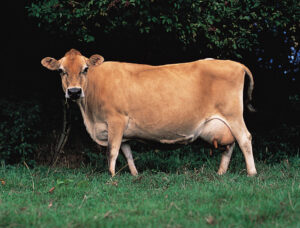When it comes to dairy cattle breeds, Jersey cattle are widely recognized for their unique characteristics and exceptional milk production. Originating from the Channel Island of Jersey, these small to medium-sized cows have gained popularity worldwide for their adaptability, high butterfat content in milk, and gentle temperament. In this article, we will explore the various characteristics that make Jersey cattle stand out among other breeds, their historical background, and the benefits they offer to dairy farmers.
History of Jersey Cattle
Jersey cattle have a rich history that dates back several centuries. The breed originated in the Channel Island of Jersey, located between England and France. It is believed that their ancestors were brought to the island by Norse settlers around 800 AD. Over time, these cattle adapted to the island’s unique environment, resulting in the development of a distinct breed with specific characteristics.
In the 18th century, Jersey cattle were introduced to other parts of Europe and North America. They were highly valued for their milk production and ability to thrive in various climates. The breed’s popularity continued to grow, and today, Jersey cattle can be found in countries all over the world.
Physical Characteristics
Jersey cattle are known for their distinctive appearance and physical characteristics. These cows are typically small to medium-sized, with a compact and muscular body. Here are some key physical features of Jersey cattle:
- Color: Jersey cattle are usually light to dark brown in color, although variations like fawn and gray can also be found.
- Head: They have a refined head with a straight or slightly dished face. The eyes are large and bright, giving them an alert expression.
- Horns: While some Jersey cattle may have horns, it is common for them to be polled (hornless) due to selective breeding.
- Body: Their body is well-balanced and streamlined, with a deep and broad chest. The back is straight and level, and the rump is slightly sloping.
- Size: Jersey cows are smaller in size compared to other dairy breeds, with mature females weighing around 800 to 1,200 pounds (360 to 540 kg).
Milk Production
One of the primary reasons why Jersey cattle are highly sought after is their exceptional milk production. Despite their smaller size, they have the ability to produce a substantial amount of high-quality milk. Here are some key characteristics of Jersey milk:
- Butterfat Content: Jersey milk is renowned for its high butterfat content, with an average percentage ranging from 4.5% to 5.5%. This makes it ideal for producing rich and creamy dairy products like butter, cheese, and ice cream.
- Protein Content: In addition to high butterfat, Jersey milk also contains a higher protein content compared to other breeds. This makes it valuable for cheesemaking and other dairy processing.
- Efficiency: Jersey cows are known for their efficient milk production. They require less feed compared to larger breeds and can convert feed into milk more effectively.
- Calving Interval: Jerseys have a relatively short calving interval, which means they can produce more calves over their lifetime. This contributes to their overall milk production and profitability for dairy farmers.
Temperament and Behavior
Another notable characteristic of Jersey cattle is their gentle and docile temperament. They are known for their friendly and curious nature, making them easier to handle and manage. Here are some key traits of their behavior:
- Gentleness: Jersey cows are generally calm and easygoing, which makes them suitable for small-scale and family-run dairy farms.
- Adaptability: These cows have the ability to adapt well to various climates and environmental conditions. They can withstand heat and humidity better than some other breeds.
- Intelligence: Jersey cattle are considered to be intelligent animals. They can quickly learn routines and respond well to training, making them easier to handle during milking and other farm activities.
- Sociability: Jerseys are known to be social animals that thrive in a herd environment. They form strong bonds with their herd mates and are less likely to display aggressive behavior.
Benefits for Dairy Farmers
Choosing Jersey cattle for a dairy farm offers several benefits for farmers. Here are some advantages they provide:
- High Milk Value: The high butterfat and protein content of Jersey milk result in a premium product that can command a higher price in the market. This can significantly increase the profitability of a dairy business.
- Efficient Use of Resources: Jersey cows are known for their efficient feed conversion, requiring less feed to produce a unit of milk compared to larger breeds. This can lead to cost savings in terms of feed expenses.
- Lower Maintenance Costs: Due to their smaller size, Jersey cattle generally have lower maintenance costs compared to larger dairy breeds. They require less space, consume less feed, and have lower healthcare expenses.
- Increased Land Utilization: The smaller size of Jersey cows allows for increased stocking rates, meaning more cows can be kept on the same amount of land. This can maximize the utilization of available pasture or grazing areas.
- Diversification: Introducing Jersey cattle to a dairy farm can provide diversification in terms of milk products. The high butterfat content opens up opportunities for value-added products like artisanal cheese, cultured butter, and premium ice cream.
Conclusion
Jersey cattle possess unique characteristics that make them a valuable asset to dairy farmers worldwide. Their adaptability, exceptional milk production, and gentle temperament contribute to their popularity in the industry. With their high butterfat and protein content, Jersey cows are capable of producing premium milk that can be transformed into a range of high-quality dairy products. Additionally, their efficient feed conversion and lower maintenance costs make them an economically viable choice for dairy farms of all sizes. By considering the various benefits offered by Jersey cattle, dairy farmers can make informed decisions to enhance the profitability and sustainability of their operations.
FAQs About Jersey Cattle
1. How long do Jersey cows typically live?
Jersey cows have a lifespan of around 12 to 15 years on average. With proper care and management, some individuals may live longer.
2. Can Jersey cattle thrive in cold climates?
While Jersey cattle are known for their adaptability, they are more suited to moderate climates. In colder regions, proper shelter and management practices should be provided to ensure their well-being.
3. Are Jersey cows suitable for grazing systems?
Yes, Jersey cows can be well-suited for grazing systems. Their smaller size and efficient feed conversion make them ideal for utilizing available pasture and maximizing land utilization.
4. How much milk does a Jersey cow produce per day?
The average milk production of a Jersey cow ranges from 10 to 16 liters per day. However, individual production can vary based on factors such as genetics, nutrition, and management.
5. Are Jersey cattle more prone to certain health issues?
While Jersey cattle are generally considered healthy and hardy, they may have a higher risk of developing metabolic disorders like ketosis and fatty liver syndrome. Proper nutrition and preventive measures can help mitigate these risks.
Summary
Jersey cattle, with their unique characteristics and exceptional milk production, have become a favored choice for dairy farmers worldwide. Originating from the Channel Island of Jersey, these cows have a rich history dating back centuries. Their physical traits, including their distinctive color and compact body, make them easily recognizable. Jersey milk, with its high butterfat and protein content, is highly sought after for its quality and versatility in dairy processing. Additionally, their gentle temperament, adaptability, and cost-effectiveness make Jersey cattle a valuable asset to dairy operations of all sizes. By considering the benefits offered by Jersey cattle, dairy farmers can make informed decisions to enhance both their profitability and the quality of their dairy products.



